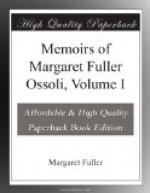“She then spoke of life, as the art, of which these all were beautiful symbols; and said, in recurring to her opinions expressed last winter, of Dante and Wordsworth, that she had taken another view, deeper, and more in accordance with some others which were then expressed. She acknowledged that Wordsworth had done more to make all men poetical, than perhaps any other; that he was the poet of reflection; that where he failed to poetize his subject, his simple faith intimated to the reader a poetry that he did not find in the book. She admitted that Dante’s Narrative was instinct with the poetry concentrated often in single words. She uttered her old heresies about Milton, however, unmodified.
“I do not remember the
transition to modern poetry and Milnes;
but she read (very badly indeed)
the Legendary Tale.
“We then had three conversations upon Sculpture, one of which was taken up very much in historical accounts of the sculpture of the ancients, in which color was added to form, and which seemed to prove that they were not, after all, sufficiently intellectual to be operated on by form exclusively. The question, of course, arose whether there was a modern sculpture, and why not. This led us to speak of the Greek sculpture as growing naturally out of their life and religion, and how alien it was to our life and to our religion. The Swiss lion, carved by Thorwaldsen out of the side of a mountain rock, was described as a natural growth. Those who had seen it described it; and Mrs. —— spoke of it. She was also led to the story of her acquaintance with Thorwaldsen, and drew tears from many eyes with her natural eloquence.
“Mrs. C. asked, if sculpture
could express as well as painting
the idea of immortality.
“Margaret thought the Greek art expressed immortality as much as Christian art, but did not throw it into the future, by preeminence. They expressed it in the present, by casting out of the mortal body every expression of infirmity and decay. The idealization of the human form makes a God. The fact that man can conceive and express this perfection of being, is as good a witness to immortality, as the look of aspiration in the countenance of a Magdalen.
“It is quite beyond the power of my memory to recall all the bright utterances of Margaret, in these conversations on Sculpture. It was a favorite subject with her. Then came two or three conversations on Painting, in which it seemed to be conceded that color expressed passion, whilst sculpture more severely expressed thought: yet painting did not exclude the expression of thought, or sculpture that of feeling,—witness Niobe,—but it must be an universal feeling, like the maternal sentiment.”
* * * * *
“March 22, 1841.—The question of the day was, What is life?
“Let us define, each
in turn, our idea of living. Margaret did
not believe we had, any of
us, a distinct idea of life.




